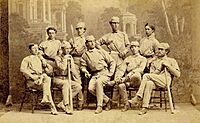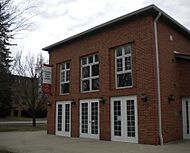Antioch College facts for kids
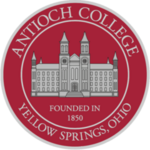 |
|
| Motto | Be ashamed to die until you have won some victory for humanity. |
|---|---|
| Type | Private liberal arts college |
| Established | 1850 (historical), 2011 (reopening) |
| Endowment | $21.2 million |
| President | Jane Fernandes |
| Provost | Brian Norman |
|
Academic staff
|
23 |
|
Administrative staff
|
56 |
| Students | 127 |
| Location |
,
United States
|
| Campus | Rural |
| Colors | Crimson, white, black |
| Affiliations | Great Lakes Colleges Association Global Liberal Arts Alliance |
| Mascot | Antioch Free Radicals (historical) |
 |
|
Antioch College is a private liberal arts college in Yellow Springs, Ohio. It was founded in 1850 by a religious group called the Christian Connection. The college opened in 1852. Its first president was Horace Mann, a famous education reformer.
From the very beginning, Antioch has been known for its forward-thinking ideas. It was one of the first colleges in the United States to admit African-American students on an equal basis with white students. The college has faced money problems several times in its history. It has even had to close and then reopen.
A key part of an Antioch education is its co-op program. All students must participate in this work-study program. It allows them to get real-world job experience while they are still in school. Two Nobel Prize winners, José Ramos-Horta and Mario Capecchi, are connected with the college.
History of Antioch College
|
Antioch Hall, North & South Halls
|
|
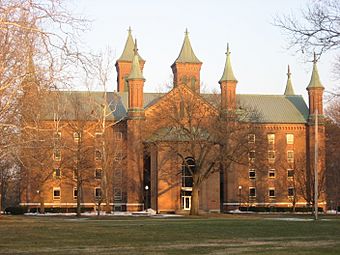
Rear of Antioch Hall
|
|
| Location | 1 Morgan Place, Antioch College campus, Yellow Springs, Ohio |
|---|---|
| Area | 3 acres (1.2 ha) |
| Built | 1852 |
| Built by | Alpheus M. Merrifield |
| Architect | Boyden & Ball |
| Architectural style | Romanesque Revival |
| NRHP reference No. | 75001411 |
| Added to NRHP | June 30, 1975 |
Antioch College was built on land that was once a small community trying to create a perfect society. This community, based on utopian socialist ideas, only lasted for about half a year in 1825.
In 1850, a group called the General Convention of the Christian Church decided to start a college. They wanted to raise $100,000 for it. A special committee decided that the college would give "equal privileges to students of both sexes," which was a very progressive idea at the time.
Early Years and Challenges
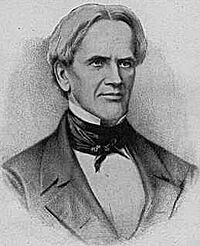
Horace Mann was the college's first president, from 1853 until he died in 1859. The college had high academic standards. Students studied subjects like Latin, Greek, math, and science. The school's motto comes from Mann's last speech: "Be ashamed to die until you have won some victory for humanity."
The college faced money problems from the start. It often did not have enough money to pay its bills. In 1862, the college closed because of these financial troubles and the Civil War. It reopened in 1865 with help from the American Unitarian Association.
A Place for Everyone
Antioch has a long history of promoting equality. In the mid-1850s, the college's prep school admitted two African-American girls. This was very unusual for that time. One of the first professors, Rebecca Pennell, was the first female college professor in the U.S. to earn the same pay as male professors.
A Baseball First
In 1869, the Antioch baseball team, known as the Antiochs, played a game against the Cincinnati Red Stockings. The Red Stockings were the first professional baseball team. While Antioch lost the game, they made history in another way. A later game scheduled at Antioch was rained out. This is believed to be the first-ever rainout in professional baseball history.
The 20th Century
The college's money problems continued into the 1900s. In 1919, Arthur Ernest Morgan, an engineer, became president. He brought new ideas and helped raise money. Morgan started the cooperative education, or "co-op," program in 1921. This program combined classroom study with real work experience.
Students would study for a term and then work for a term. Male students often worked in factories, while female students worked as teaching or nursing assistants. The co-op program became a central part of the Antioch experience.
A Center for Activism
During World War II, Antioch helped students of Japanese heritage leave internment camps to attend college. In the 1940s, the college began offering scholarships to non-white students to make the campus more diverse. Coretta Scott King, who later married Dr. Martin Luther King Jr., attended Antioch on one of these scholarships.
In the 1960s and 1970s, Antioch became known for student activism. Students were involved in many social and political movements. In 1965, Dr. Martin Luther King Jr. gave the graduation speech.
The 1973 Student Protest
In 1973, students held a major protest on campus. They were concerned about cuts to federal student aid. The protest led to the college being shut down for six weeks. After the protest, many students left, and fewer new students applied to the college for many years.
A Policy on Respect
In the early 1990s, students and staff worked together to create a policy to promote respect and clear communication. The policy required students to give clear, verbal consent for any romantic activity. This idea was new at the time and received a lot of media attention. Today, many other colleges have similar policies.
The 21st Century
In 2007, the college's leaders announced that Antioch would close in 2008 due to serious financial problems. This news upset many alumni, faculty, and students. They formed groups to raise money and try to save the college.
After a lot of hard work and fundraising, a group of alumni bought the college campus and the right to use the name "Antioch College." This allowed the college to become independent again.
Reopening and Rebuilding
Antioch College reopened in the fall of 2011 with a small class of 35 students. To attract students, the college offered free tuition for the first few years. This brought in thousands of applications.
The college worked hard to rebuild. It renovated old buildings and earned its official accreditation back in 2016. Accreditation means that an outside organization has reviewed the college and confirmed that it meets high standards of quality.
However, the college has continued to face financial challenges. It has had to make budget cuts and sell some of its assets, like the campus radio station and a nature preserve, to stay open. In 2021, Dr. Jane Fernandes became the new president. She is the first deaf president in the college's history.
Academics at Antioch
Antioch College offers Bachelor of Arts and Bachelor of Science degrees. Students have a lot of freedom to design their own majors based on their interests. The college has a low student-to-faculty ratio of 7 to 1. This means classes are small, and students get a lot of personal attention from their professors.
The Co-op Program
The co-op program is still a required part of an Antioch education. All students spend four quarters working in different jobs over their four years at the college. This gives them valuable hands-on experience in fields they are interested in.
Campus Life
Antioch's campus is in the small town of Yellow Springs, Ohio. The campus has a mix of historic buildings and modern, environmentally friendly facilities.
Sustainability
Antioch is committed to being environmentally friendly. One of its oldest dorms, North Hall, was renovated to meet the LEED Gold Standard for green buildings. It uses solar panels and geothermal energy for power.
The college also has a farm where students learn about sustainable agriculture. A large solar array on campus generates over a million kilowatt-hours of clean energy each year.
Glen Helen Nature Preserve
For many years, the college owned the Glen Helen Nature Preserve. This 1,000-acre preserve was donated by an alumnus in 1929. It has miles of trails, forests, and waterfalls. In 2020, because of financial difficulties, the college transferred ownership of the Glen to a local nonprofit group. The group works to keep the preserve open for everyone to enjoy.
Images for kids



